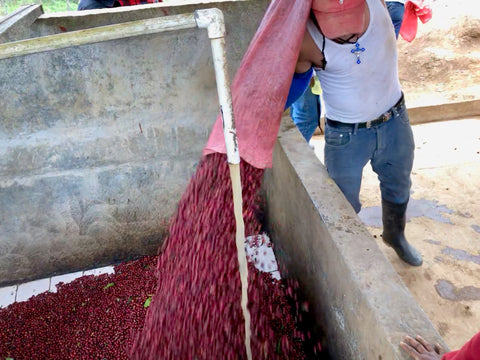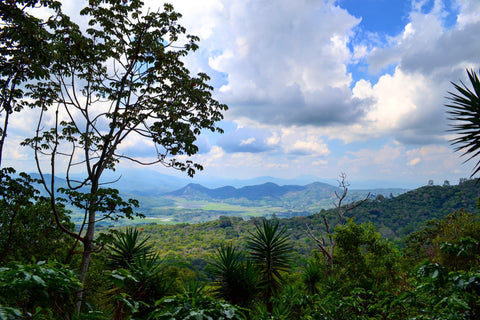As coffee professionals, we place a great deal of emphasis on how any coffee we’re evaluating is processed - think oak aged wine versus stainless steel barrel, or fresh butchered steak versus dry aged. You’ll always find a single origin coffee’s processing method listed on our labels, and if you attend any of our classes, events, or public cuppings, you’ll definitely hear us speak about the various processing methods of the coffees we offer. Though we always cover the basics of coffee processing with our customers, we understand that many of our customers may not have a full understanding of the various types of coffee processing, what they entail, and how that affects the resulting coffee in the cup.
For the past several years, we’ve been working closely with a number of our partner farms to develop new and interesting flavors and coffee offerings through experimentation and innovation in processing techniques. With the product of that work finally coming to fruition, this year we’re offering a number of Process Collections featuring multiple coffees of various processing techniques from either a single farm, mill, or region. These collections illustrate the importance of processing in developing the flavor and characteristics of any given coffee. As a companion to those collections, lets dive in to the most common processing methods to give you a better understanding of how they work, why they’re important, and how they affect the coffee you drink.
First, it is important to understand a few things about coffee agriculture and how that leads into how processing decisions are made. There are two primary species of coffee under the genus, Coffea: Arabica and Robusta. Robusta plants produce a generally high output, low quality coffee that grows at lower altitudes. Arabica plants produce a generally low output, high quality coffee grown at higher altitudes. For our purposes, we’ll be focusing specifically on Arabica coffee as it is the only species we source and roast. The coffee plant is an evergreen, originating in tropical areas of East Africa. Beginning in the late 15th century, coffee transplants began to make their way to similar climates around the world, and now over 70 countries have viable coffee cultivation. The coffee plant produces a delicate, aromatic, white flower that becomes a green cherry that ripens to red, or sometimes yellow and other colors. The fruit of the coffee plant has a tough skin surrounding a high sugar content pulp and a pit consisting of seeds encased in a hard hull or parchment. Specialty grade coffee (coffees scoring 80 points or higher on a 100 point quality scale) are generally grown at altitudes above 800masl where terrain is typically challenging. This, combined with the delicacy of the coffee plant, and the fact that coffee cherries ripen gradually, even on the same plant, makes mechanized harvesting almost impossible in most circumstances. High quality coffee is typically harvested by hand, selected for ripeness by visually assessing cherry color. A typical harvester will produce upwards of 300lb of ripe cherry per day, meaning that during harvest season, farms employ hundreds of harvesters who are paid both by the volume of coffee they harvest, but also by the quality and ripeness of cherries in their daily production. A high percentage of under or over ripe cherries can dramatically affect the overall quality marks of the finished coffee, so field managers monitor harvesters production closely at weigh-in to ensure the cherries moving to the first stages of processing are of a consistent quality and ripeness.

Because coffee cherries are high in sugar content in a warm, tropical environment, as soon as they are harvested, the fermentation clock starts ticking, so no matter what process will be used, the coffee must begin that process immediately after harvest to avoid the risk of over fermentation or rot. There are three common methods of processing coffee to get it from freshly harvested cherry to the green coffee seeds imported by roasters like us: Natural Process, Washed Process, and Honey Process. There are a number of variations of each of these processes—many of which we’ll cover—and specific circumstances that make one process or another more appropriate for a specific region or type of coffee.
Natural Process
The Natural Process, sometimes also referred to as “dry process”, is the oldest method of processing coffee. The process, as the name suggests, does not use water, which was a crucial factor in its early development in areas like Yemen and Ethiopia where water resources are scarce. The method is simple: freshly harvested coffee cherries are spread out onto stone patios or on raised screen beds to dry in the sun. Much like making raisins from grapes, the fruit dries in the sun, imparting fruit flavors into the seed. As the fruit dries, it also ferments, imparting winey or acetic acid flavors into the seed as well. These flavors can be exciting and highly desirable if the coffee is handled properly, but over fermentation and rot can occur quickly, causing the coffee to cross the line from wine notes to vinegar, so naturally drying cherries must be turned constantly as they dry, keeping moisture levels even throughout the drying process. Though there are some mechanical drying methods in use, most Natural Process coffee must be produced in arid climates that have very little chance of rain. Yemen produces Natural Process coffees exclusively, due to its lack of water resources, but most other coffee producing countries employ a combination of Natural Process and other methods. Once the sun-dried cherries reach an appropriate moisture level—usually after 2-4 weeks—the dried hulls are milled off the coffee seed and discarded or used for compost. Natural Process coffees are typically fruity in character, often presenting intense aromas of berries, fresh wine, balanced by chocolatey body. Acidity is often muted in Natural Process coffees, and there can be a great deal of variation from cup to cup. Because of this variability, there is some debate over the place of Natural Process coffees in Specialty Coffee, but we find that the rich body and fruity character of a good Natural Process coffee works very well in blends as well as single origin offerings.

Washed Process
The Washed Process, sometimes also referred to as the “wet process” is the most widely used coffee processing method today. As the name suggests, the process involves water, which does create sustainability challenges for some growing regions, but modern conservation techniques and processing equipment are allowing Washed Process coffees to become more and more prevalent each season. The Washed Process involves several steps to get from freshly harvested cherries to seeds in parchment ready to dry. The freshly harvested cherries are immediately milled to remove the outer skin, leaving the sugar-rich, sticky mucilage around the parchment intact. These sticky seeds are placed in a holding tank and allowed to begin fermentation. After fermentation has started to break down the sugars of the sticky mucilage, fresh water is added to the tanks, washing the mucilage off the parchment and seeds. The mixture is then allowed to flow through a series of canals. The highest quality coffee, which has a higher density, will sink to the bottom of the canal, while the lower quality, less dense seeds will float. A system of gates in the canal allow the lower quality coffee to flow over the gates to the end of the canal where they can be collected and processed separately for the commodities market. The higher density, higher quality coffees remain in the canal an continue to wash until all the floaters have passed. The gates are then removed and the high quality coffee is gathered to be set to dry. At this point the coffee seed is in a clean, hard hull with a yellowish white color, and it is set out to dry similarly to the Natural Process, on stone patios or raised screen beds. Washed Process coffees still need to be turned regularly, but are far less prone to over fermentation or rot than Natural Process coffees. Once the parchment coffee has reached optimal moisture levels, it is transferred into coffee sacks in “reposa”, or rest, where the coffee is stored until it is ready for export. Storage in reposa allows the moisture levels to continue to regulate and level out, and when the coffee is ready for export, it is hulled and sorted, then packaged and sealed in 60 or 70 kilo bags for transport. Washed Process coffees are known for consistency and clarity of flavor and acidity, and for this reason, often prized by coffee enthusiasts looking for coffees they can rely on to produce consistent results in the cup.

Honey Process
The Honey Process combines elements of both the Washed and Natural Process Methods. The process was originally developed in Costa Rica in an attempt to replicate flavors produced by the related Pulped Natural process developed in Brazil. Brazil’s Pulped Natural process removes the skin and much of the pulp of the coffee fruit from the seed, leaving some residual sugar to dry on the parchment while using a very small amount of water. This process created soft, silky body, and subtle fruit flavors with low-altitude Brazilian coffees - a profile that was popular with buyers around the world. When Brazil faced multiple years of heavy draught that crippled their coffee production in the 80s and 90s, the world looked to other growing regions that might be able to replicate that profile. Costa Rica’s answer was a slight variation on the Pulped Natural Process that left slightly more pulp and mucilage on the parchment to ferment and soften the profile of the somewhat more acidic Costa Rican coffees. Since the late 90s and early 2000s, popularity of Honey Process coffees has been steadily growing. There are three variations on the process: Yellow Honey, Red Honey, and Black Honey—honey used as a term to describe the sweet, sticky mucilage, or pulp. Each variation refers to the amount of pulp left on the parchment to dry—the more pulp, the darker the color as it dries. Honey Process coffees are exciting because they offer some of the body, fruit, and fermentation of Natural Process coffees, along with the clarity and consistency of Washed Process coffees. Acidity in Honey Process coffees is often softened, creating more subtle complexity and a sweeter, more silky cup. The downside to Honey Process coffees is that they are far more labor intensive than any other processing method, with a far higher risk of rot or over fermentation. Because the high-sugar pulp is exposed, and not protected by the coffee’s thick skin as in the Natural Process, rot and mold are prevalent in Honey Process coffees, so producers must attend to turning the beds throughout the day and night to avoid losing the entire production. When executed correctly, however, quality Honey Process coffees can dramatically improve the price farmers are able to fetch for their coffee.

Coffee processing is truly the one area of coffee production that has the most dramatic affect on what ultimately becomes the coffee in your cup. As producers and roasters come to this realization and begin to work together to push the limits of what is thought possible from coffees from specific regions, new innovations begin to pop up, bringing the industry new, exciting flavors from unexpected sources. So much of coffee processing is done by farmers simply processing coffee the way they were taught by their mothers and fathers—largely unscientific methods that work because they’ve worked for generations. Now a new generation of farmers and roasters is applying scientific method to those trusted techniques to create new flavors though new methods, rooted in quantifiable, repeatable science; building sustainability and resilience in the specialty coffee industry.





